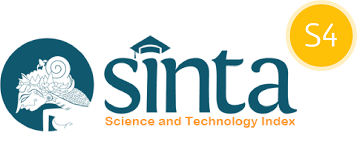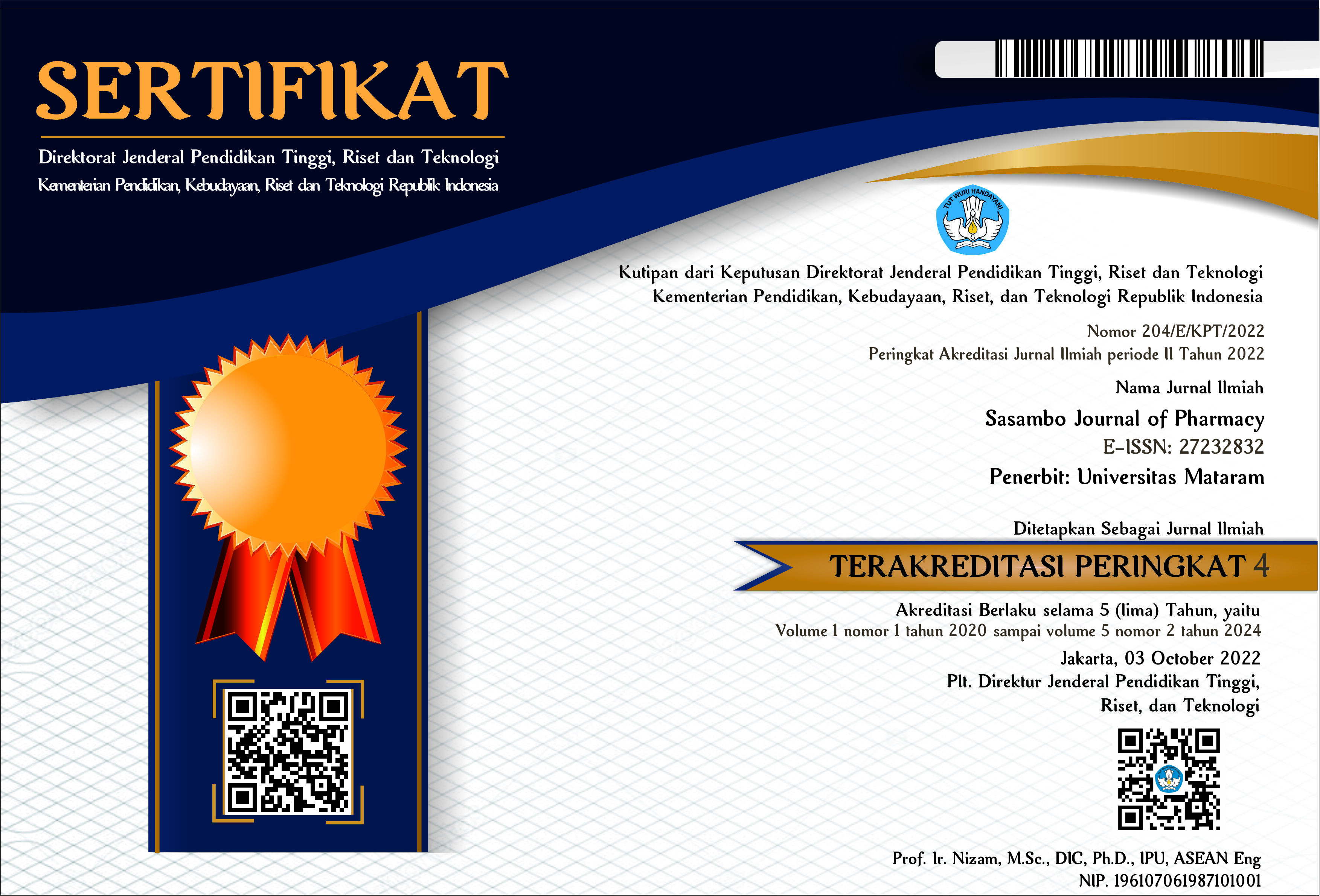Formulasi serum antiaging nanopartikel emas dengan fraksi daun sirih hutan gambut Kalimantan (Piper aduncum)
DOI:
10.29303/sjp.v6i1.401Downloads
Abstract
Free radicals are molecules with unpaired electrons that are reactive and unstable. Gold nanoparticles (AuNPs) have an antioxidant reducing Au3+ to Au+ which can stabilize free radicals. This research aims to characterize AuNPs, formulate and evaluate AuNPs antiaging serum with sirih hutan leaves fraction and antioxidant activity test. The research method used was maceration, sirih hutan leaves were extracted using 96% ethanol, fractionation using n-hexane, biosynthesis of AuNPs, formulation, and antioxidant activity using the DPPH method. The data analysis used One Way Anova test and post hoc Tukey (CI 95%). The research results showed that ethanol extract and n-hexane fraction were obtained at 132.5059 g and 18.3804 g respectively. Biosynthesis characterization of AuNPs have a particle size of 424.9 nm. Formulation and evaluation of AuNPs formulation were generally obtained according to SNI. The antioxidant activity of the formulation and vitamin C showed that the percentage of DPPH increased with increasing concentration, IC50 values of the formulaion and vitamin C showed 35.21 ± 0.95; 17.95 ± 0.34 ppm respectively. Based on One Way Anova test, there was significant difference in each concentration in the percentage of DPPH (p<0.05). and the formulation and vitamin C were classified as very strong antioxidants (IC50<50).
Keywords:
sirih hutan leaves, gold nanoparticles, formulation, antioxidantsReferences
Aktumsek, A., Zengin, G., Guler, G.O., Cakmak, Y.S., & Duran, A. (2016). Antioxidant potentials and anticholinesterase activities of methanolic and aqueous extracts of three endemic Centaurea L. species. Food Chem. Toxicol. 55:290–296. https://doi.org/10.1016/j.fct.2013.01.018.
Ali, S. S., Ahsan, H., Zia, M. K., Siddiqui, T., & Khan, F. H. (2020). Understanding oxidants and antioxidants: Classical team with new players. Journal of Food Biochemistry, 44(3). https://doi.org/10.1111/jfbc.13145.
Arina, N. B., & Rohman, A. (2015). The phenolic contents and antiradical activity of Indonesian Phyllantus urinaria L. International Food Research Journal. 20(3):1119-1124.
Boly, R., Lamkami, T., & Guissou, I. (2016). DPPH free radical scavenging activity of two extracts from agelanthus dodoneifolius (Loranthaceae) leaves. Int J Toxicol Pharmacol Research, 8(1),29-34. https://www.semanticscholar.org/paper/DPPH-free-radical-scavenging-activity-of-two-from-Boly-Lamkami/77f38b4576ec817d93e49a581d84b51d80b05a58h.
Lai-Cheong, J. E., & McGrath, J. A. (2017). Structure and function of skin, hair and nails. Medicine (United Kingdom). 45(6):347–351. http//doi.org/10.1016/j.mpmed.2017.03.004.
Najib, Ahmad. (2018). Ekstraksi Senyawa Bahan Alam. Deepublish.
Neha, K., Haider, M. R., Pathak, A., & Yar, M. S. (2019). Medicinal prospects of antioxidants: A review. European Journal of Medicinal Chemistry, 178, 687–704.https://doi.org/10.1016/j.ejmech.2019.06.010h.
Putri, F.A., Diharmi, A., & Karnila., R. (2023). Identifikasi Senyawa Metabolit Sekunder pada Rumput Laut Cokelat (Sargassum plagyophyllum) dengan Metode Fraksinasi. Jurnal Teknologi dan Industri Pertanian Indonesia. 15(1):41-46. https://doi.org/10.17969/jtipi.v15i1.23318.
Rudiana, T., Indiatmoko, D, D., & Rohim, D. (2021). Aktivitas Antioksidan dan Profil Senyawa Metabolit Sekunder Ekstrak Kulit Batang Alkesa (Pouteria campechiana). (2021). Chimica et Natura Acta, 9(1). https://doi.org/10.24198/cna.v9.n1.33567.
Sartika D., Rahmi, M., & Noor fajriwianti, D. (2021). Uji Efektivitas Salep Ekstrak Daun Sirih Hutan (Piper aduncum L.) Terhadap Penyembuhan Luka Bakar Pada Mencit Putin Jantan. Jurnal Katalisator. 6(2):308–316)http://doi.org/10.22216/jk.v5i2.5717.
Slamet, S., & Anggun, B.D. (2020). Uji Stabilitas Fisik Formula Sediaan Gel Ekstrak Daun Kelor (M. oleifera). Jurnal Ilmu Kesehatan. 13(2):115-122. http://doi.org/10.48144/jiks.v13i2.260.
Sovawi, A. C., Harjono, H., & Kusuma, S.B.W. (2016). Sintesis Nanopartikel Emas dengan Bioreduktor Ekstrak Buah Jambu Biji Merah (Psidium guajava L.). Indonesian Journal of Chemical Science. 5(3):169-173. http://doi.org/10.15294/ijcs.v5i2.11704.
Susanty, S., & Bachmid, F. (2016). Perbandingan Metode Ekstraksi Maserasi dan Refluks Terhadap Kadar Fenolik dari Ekstrak Tongkol Jagung (Zea mays L.). Jurnal Konversi, 5(2), 87. https://doi.org/10.24853/konversi.5.2.87-92).
Vellayanti, S. (2020). Formulasi dan karakterisasi sediaan serum nanopartikel emas daun tin (Ficus carica L.). Skripsi. Universitas Islam Indonesia.
Wardiyah, (2016). Kimia Organik. Jakarta. Penerbit Kementerian Kesehatan Republik Indonesia.
Wiyanto, A. & Nurhamidah. (2023). Analisis Pengaruh Nano Partikel terhadap Aktivitas Anti Aging. Jurnal Lentera:Penelitian dan Pengabdian Masyarakat. 4(1):25-29.
Yanti, D. & Nurhayati, N. (2022). Formulasi sediaan serum mengandung nanopartikel Emas yang dibuat dengan bioreduktor ekstrak Daun mangkokan (polyscias scutellaria). Jurnal Katalisator. 2(1):45-53.
License
Copyright (c) 2025 The Author(s)

This work is licensed under a Creative Commons Attribution 4.0 International License.
Authors who publish with Sasambo Journal of Pharmacy (SJP), agree to the following terms:
- Authors retain copyright and grant the journal right of first publication with the work simultaneously licensed under a Lisensi Creative Commons Atribusi 4.0 Internasional. This license allows authors to use all articles, data sets, graphics and appendices in data mining applications, search engines, web sites, blogs, and other platforms by providing an appropriate reference. The journal allows the author(s) to hold the copyright without restrictions and will retain publishing rights without restrictions.
- Authors are able to enter into separate, additional contractual arrangements for the non-exclusive distribution of the journal's published version of the work (e.g., post it to an institutional repository or publish it in a book), with an acknowledgment of its initial publication in Sasambo Journal of Pharmacy
- Authors are permitted and encouraged to post their work online (e.g., in institutional repositories or on their website) prior to and during the submission process, as it can lead to productive exchanges, as well as earlier and greater citation of published work (See The Effect of Open Access).







